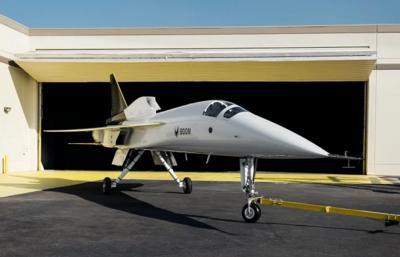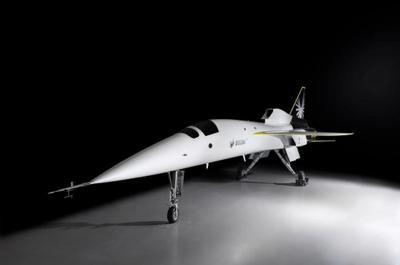Overture’s Overture
Boom Supersonic, the American company about the highly-speculative business of designing and producing a supersonic airliner dubbed the Boom Overture, has reportedly achieved a number of milestones vis-à-vis the development of its XB-1 Baby Boom—a one-third-scale technology demonstrator devised to vet technologies salient to the planned airliner.

Rolled out in October 2020, the XB-1 comprises advanced fiber-composites, bleeding-edge avionics, and digitally-optimized aerodynamics ostensibly conducive to sustained and sustainable supersonic flight. The aircraft is alleged to be capable of attaining and maintaining cruise flight at Mach 2.2 (1,455-knots) over a claimed range of one-thousand nautical-miles. The machine is powered by a trio of 4,300-lbf General Electric J85-15 single-shaft turbojet engines.
In April 2023, the XB-1 was moved from Boom’s Centennial, Colorado hangar to California’s Mojave Air & Space Port, where the contraption has since undergone extensive ground-testing—to include taxi-testing which got underway the week of 20 August.
Boom Supersonic founder and CEO Blake Scholl stated: “The recent progress made towards XB-1’s first flight reflects the team’s collective efforts to build and safely fly the world’s first independently developed supersonic jet.”
In addition to ongoing ground-testing, the XB-1—following a comprehensive technical inspection—has been granted an experimental airworthiness certificate by the Federal Aviation Administration. The agency has also issued letters of authorization permitting Boom chief test-pilot Bill “Doc” Shoemaker and test-pilot Tristan “Gepetto” Brandenburg to fly the XB-1. Moreover, letters of agreement allowing flights of the aircraft over the Mojave desert are in place with pertinent airspace authorities.
Presuming continued nominal development, the XB-1’s first flight will be conducted in the airspace through which Captain Charles “Chuck” Yeager piloted the Bell X-1 Glamorous Glennis during his historic, sound-barrier-breaking 1947 flight. Seventeen-years later, the selfsame airspace was rent asunder during the 1964 maiden flight of the Mach 3+ SR-71.
In preparation for the XB-1’s inaugural flight, Boom’s test-pilots—by way of a proprietary simulator—have dedicated hundreds of hours to evaluating the aircraft’s predicted performance, developing cockpit procedures and checklists, and assessing the unique human-factors they’re likely to face whilst piloting the XB-1. For purpose of maintaining stick-and-rudder proficiency, the test-pilots make regular flights in a T-38 Talon—the same aircraft slated to serve as a chase-plane for all XB-1 test-flights.

Mr. Shoemaker confided: “It’s fitting that XB-1 is now progressing toward first flight at the Mojave Air & Space Port, home to more than fifty first-flights and other significant aviation events. I’m looking forward to flying XB-1 here, building on the achievements of other talented engineers and pilots who inspire us every day to make supersonic travel mainstream.”
Measuring 71-feet in length, the XB-1 features a carbon composite and titanium fuselage and a modified delta-wing allegedly suited to safe subsonic, transonic, and supersonic flight.
Boom Supersonic contends the XB-1 has validated the company’s approach to airplane design and enabled engineers to leverage advanced tools, such as computational fluid dynamics (CFD), critical to Overture’s development.
Viewed through the admittedly distorted lens of projected specifications, Boom’s Overture is a supersonic aircraft with an advertised maximum speed of Mach 1.7 and a range of 4,250-nautical miles. The 170,000-pound machine is to be powered by a quartet of yet-to-be-designed, moderate-bypass, non-afterburning engines. The only extant engines capable of actualizing Boom’s performance figures are slung under and alongside modern jet-fighters. Such mills, however, lack the fuel-economy and reliability upon which viable commercial aviation operations are predicated.
Boom intends to run its non-existent engines on one-hundred-percent sustainable aviation fuel.
According to Boom, a typical Overture flight would move 65 to 80 passengers from Miami to London in just under five-hours; a trip from Los Angeles to Honolulu would take a scant three hours. Notwithstanding the infancies of numerous requisite technologies, Boom expects the Overture will carry its first paying passengers by 2029.

Boom’s books presently contain orders and options for no fewer than 130 Overture aircraft from air-carriers such as American, United, and JAL. In addition to its civilian undertakings, Boom is working with Northrop Grumman to rouse the Pentagon’s interest in Overture.
Suppliers and partners collaborating with Boom on its high-speed, higher-stakes wager include Collins Aerospace, Eaton, Safran Landing Systems, Kratos Defense, Florida Turbine Technologies, Standard Aero, the United States Air Force, American Express, Climeworks (a Swiss company specializing in carbon-dioxide air-capture via filtration of CO2 directly from ambient air), and Amazon Web Services.
Whether or not Overture emerges from the drawing board remains to be seen. What can be stated with certainty, however, is that fortune favors and abhors the brave in equal measure, and that the borderlands separating the improbable from the impossible are vast and unknowable.
 ANN's Daily Aero-Term (05.09.24): Hold Procedure
ANN's Daily Aero-Term (05.09.24): Hold Procedure ANN's Daily Aero-Term (05.06.24): Altitude Readout
ANN's Daily Aero-Term (05.06.24): Altitude Readout ANN's Daily Aero-Linx (05.06.24)
ANN's Daily Aero-Linx (05.06.24) Airborne-NextGen 05.07.24: AI-Piloted F-16, AgEagle, 1st 2 WorldView Sats
Airborne-NextGen 05.07.24: AI-Piloted F-16, AgEagle, 1st 2 WorldView Sats Aero-News: Quote of the Day (05.07.24)
Aero-News: Quote of the Day (05.07.24)





